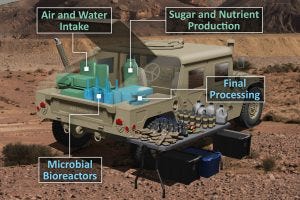Mission from DARPA: Create food from thin air
Chao Wang and Michael Tsapatsis collaborate with Johns Hopkins APL on the "Cornucopia" program.
by Johns Hopkins Whiting School of Engineering
For a team of Johns Hopkins researchers, the challenge of feeding people during times of crisis or conflict is an opportunity to dramatically reinvent how food is made: out of almost nothing.
The Johns Hopkins Applied Physics Laboratory is home to one of four teams selected for the Defense Advanced Research Projects Agency’s (DARPA) Cornucopia program, attempting to unlock the potential to produce nutritionally complete, palatable foods in the field. The group is using electricity to capture water, carbon dioxide, nitrogen and trace minerals from the air and then producing a rich, glucose-based material (called feedstock) on which to grow microbial food products.
Feedstock refers to a raw material that is used as fuel or converted to another form of fuel or energy product. For example, crude oil is a feedstock used to create gasoline, corn is used to produce ethanol, and soybean oil is used to produce biodiesel.
“Yes, we are aiming to create food from thin air,” said Collin Timm, a chemical and biological engineer at APL and principal investigator for the team. “It would be a revolutionary capability to be able to produce food on demand in any setting.”
Associate Professor Chao Wang and Bloomberg Distinguished Professor Michael Tsapatsis, two faculty members at the Whiting School of Engineering’s Department of Chemical and Biomolecular Engineering and its Ralph S. O’Connor Sustainable Energy Institute, are working with the APL team to help develop these upstream complex processes. Both have experience creating useful products from atmosphere carbon.
Wang is focused on using electrochemical methods to capture CO2 from the air, while Tsapatsis is working on catalytic conversion of C1 intermediates (molecules or chemicals that contain one carbon atom) into sugar.
“Our process is focused on generating a central, rich feedstock from the components in air to support the growth of food microbes,” explained APL’s William Stone, a molecular biologist overseeing this aspect of the project. The team will capture carbon dioxide from the air and reduce it into simple organic molecules, such as formate and acetate, using sequential chemical reactors. Those products, in turn, will be converted into sugars.
“We are using upstream technologies to convert air and electricity into molecular building blocks, such as sugars and fixed nitrogen, that are required for microbes,” Stone said. “Downstream food-safe microbes then use this feedstock to efficiently produce all the macronutrients and vitamins to be included in food products. Marrying the upstream and downstream processes is a complex systems integration challenge that we are well prepared to tackle.”
DARPA has also challenged the teams to create a manufacturing and housing system that could fit on the back of a truck, which deployed troops could use to make nourishing and appetizing food on demand in remote locations, removing the need for costly and vulnerable food supply chains.
The current primary source of nutrition in many military operations — called Meal, Ready-to-Eat, or MRE — is not recommended as a sole source of food for long missions, not approved for civilian use and not tailored for age and gender differences.
“We aim to extract as many of the nutrients microbes need to produce food from the air as possible.” Stone said. “We will even capture dust and other particulate matter and extract trace minerals like iron and magnesium that are needed for nutritionally complete food products.”
APL’s approach, dubbed RePLICaTE—for Reducing Provisions and Logistics Inputs through Calorie Transformation from Electricity—is focused on delivering a working prototype, demonstrating a leap forward in food production on demand. Collaborators on the project include North Carolina State University and Meridian Biotech.
This new program benefits from APL’s decades of work on projects designed to directly support soldiers in the field. Timm noted that the Laboratory has, for some time, focused on unburdening the warfighter and ensuring access to resources on demand.
Recently, APL scientists have undertaken internally funded projects to produce glucose from microbes and engineer microbes for food production.
The team is also motivated by the impact RePLICaTE could have on the planet’s changing climate. Those early research projects provided critical proofs of concept and preliminary data for RePLICaTE, APL’s latest foray in a growing effort to address climate change and its impacts.
“As part of our work in this area, we’ve been very interested in the resilience of food systems, and we’ve been investing in the development of technologies to provide for basic needs when climate change-induced extreme weather strikes,” said Marisa Hughes, the environmental resilience research lead in APL’s Research and Exploratory Development Department.
This story was adapted from an APL story
Go paid at the $5 a month level, and we will send you both the PDF and e-Pub versions of “Government” - The Biggest Scam in History… Exposed! and a coupon code for 10% off anything in the Government-Scam.com/Store.
Go paid at the $50 a year level, and we will send you a free paperback edition of Etienne’s book “Government” - The Biggest Scam in History… Exposed! OR a 64GB Liberator flash drive if you live in the US. If you are international, we will give you a $10 credit towards shipping if you agree to pay the remainder.
Support us at the $250 Founding Member Level and get a signed high-resolution hardcover of “Government” + Liberator flash drive + Larken Rose’s The Most Dangerous Superstition + Art of Liberty Foundation Stickers delivered anywhere in the world. Our only option for signed copies besides catching Etienne @ an event.







This stuff baffles me, like little Billy Gates' low-down butter... Logically, using the evil air would obviate the need for net zero, n'est-ce pas? In fact, is it not shooting oneself in the foot to get rid of carbon and nitrogen if they are essential ingredients for the magic porridge pot (as well as actual life on the planet, of course)?